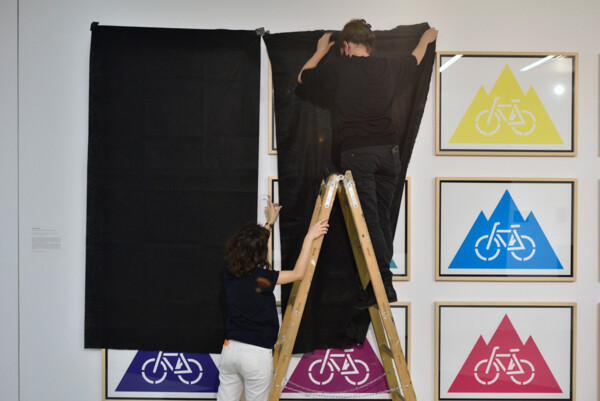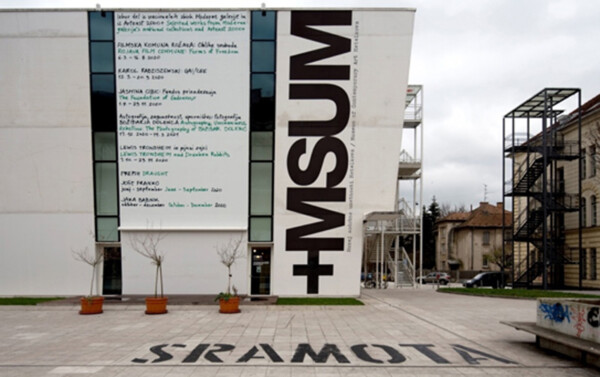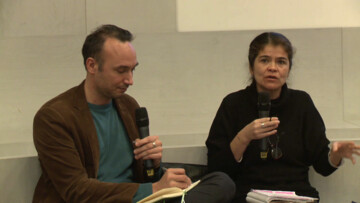At the Moderna galerija, we have asked ourselves what it is that constituencies actually constitute. Seeing that we work within a very small community – Ljubljana only has a population of 300,000 – it is virtually impossible to think about the institution other than in relation to other agents in the community [...] We think about our community in terms of a biotope of sorts, in which every species, every agent, regardless of their status, is important for the survival of the community. For this reason, it is important to think about the institution both as just one of many constituencies, and as a space co-created by others.
— Zdenka Badovinac, at the “Constituencies”, Glossary of Common Knowledge seminar, John Moores University, 2016.
The biotope[1] of which Zdenka spoke so enthusiastically in Liverpool in 2016 has since been destroyed in Slovenia, and the conditions for its species/constituencies to live, to flourish and to form an assemblage with other species/constituencies have been altered.
At the Liverpool seminar, the introduction also read: “Constituencies are always in flux, depending for their existence upon their relationships with one another. As such, constituencies are never givens – but always something to be struggled over and → negotiated.”
But is this kind of reasoning sustainable? What about the responsibility/→ care (→ care)/→ solidarity for other species/constituencies of a biotope/community when one species finds itself in a difficult situation? How to regenerate a damaged biotope/community, and also – with whom? In this short contribution some of these dilemmas – also observed in light of the current situation at the Moderna galerija – will be posed as open questions.
As Yaiza Hernandez put it some years ago: a million symposia about the constituent museum do not make a constituent museum. It requires instead a wholesale exercise of a radical, instituting → imagination. While I agree with Yaiza, I think now we are in a situation where the exercise she mentioned needs to be translated into practice: concrete proposals and tools thought of as practice.
One of the consequences of the drastic political and social changes in Slovenia which started in 2020 was an aggressive turn to national culture, conservativism and populism, resulting in removing critical voices from institutions and in politically motivated appointments of the directors in those institutions, including the Moderna galerija. This has been, in short, a time of attempted “silencing”, with the systematic destruction of democracy and the rule of law, attacks on the media as well as the dissolution of the welfare state – all of which has deeply affected the entire cultural habitat. But this new right conservative cultural politics has not been directly enforcing the “nationalistic sentiment”, they have learned their lesson and are actually smarter than that, but rather has demanded that art and culture institutions be “neutral”, i.e. preventing any criticism, dissent, or positioning within a museum and keeping the status quo of an art institution as a colonial institution of exclusion, also in relation to the constituents. Similar to what Laura Raicovich reports on in her book Culture Strike. Art Museums in an Age of Protests. In the book Raicovich deals with this question of “neutrality” in museums and how it has become difficult for museums to remain relevant in this context, noting that neutrality is just a veil for wielding power: this is the status quo that requires resistance.[2]
In case of Slovenia and also the Moderna galerija the consequences of the drastic changes in cultural politics were as follows.
Conditions of cultural production have worsened
On the one hand, the independent cultural scene (including the many NGOs) and cultural workers/artists have lost the majority of the financial resources needed to continue their work. It is important to know that in Slovenia cultural activities have always depended on the state budget (a remnant from socialism) more than on other sources of funding, which are scarce, just some funds from the European Union and in some cases municipal funding. There is basically no art market in Slovenia, and no private sponsors/donors for art. So it can be said that the issue of how to overcome the division between art production and wage labour became not only a survival strategy in recent years but a political problem, one that has been especially accentuated during the last two years (with the political changes and the COVID pandemic).
On the other hand, though, the national institutions’ budgets (like that at the Moderna galerija) have increased, but it is important to know that all the new directors of these institutions were politically installed in the last two years, so these budget increases are of course also a political decision. The logic of the Ministry of Culture is that NGOs would not receive direct funding for their programmes as before, but their activities would instead be “funded” via the national institutions (museums, etc.). These institutions would themselves decide which NGOs/independent organisations they wanted to collaborate with. So we are talking about a new and rather dangerous dependent relationship between the institutions (museums) and NGOs based on “ideological appropriateness” and at the same time silencing or even expunging of critical voices not only from these institutions, but also from the independent cultural scene. According to the logic of the current cultural policymakers, these new “enforced” networks would play the role of the new constituents of a particular institution.
Artistic autonomy has been put under question
The question of autonomy is again closely related to the conditions of cultural production. Meaning if you are not ideologically acceptable according to the Ministry of Culture criteria, then the financial flows are limited or cut altogether. So these include critical voices, opponents of the current politics, and the “wrong” research or → exhibition topics (for example Yugoslavia/socialism). We have also seen numerous cases of historical revisionism lately, for example in the National Museum of Contemporary History of Slovenia (mainly dealing with the World War Two and the 1990s). The cultural sphere in Slovenia has now become more than ever a sphere of ideological struggles.
Artists, cultural workers and activists have reacted strongly to those changes and attempts to reshape the country’s cultural life, with regular protests, including street demonstrations, → direct action and open letters… The protesters in 2020 established the Protest People’s Assembly and their demands, ideas and so on were presented as guidelines, a sort of a call to all parts of civil society to activate, communicate and participate in the common struggle for a better future. One of the demands reads: Real power should be given to artists, organisations and groups to influence key decisions in culture, that is – to all those excluded from the process of cultural policymaking.

Maja Smrekar, Eulogy to Evolution, 10 October 2021, participatory performance. Museum of Contemporary Art Metelkova (+MSUM). In the performance the artist and participants covered all the works from the REALIZE! RESIST! REACT! Performance and Politics in the 1990s in the Post-Yugoslav Context in black cloth. Photo: Dejan Habicht/Moderna galerija, Ljubljana.
In these and similar actions new kinds of constituencies (“communities in becoming”) can be recognised. There has been a specific solidarity among the self-employed in culture, cultural institutions (not cultural institutions per se but the critical part within the institutions), and a variety of networks/platforms/collectives, at least when it comes to the two points I mentioned. It seems the new constituencies, even though they differ from each other and are not always in the same artistic or even ideological line, are now quite united in their common political, social and economic calls for change.
But how can these constituent networks remain sustainable in the long run?
And what does it actually mean for us, in Slovenia, in the Moderna galerija, to have a museum today? Amidst the current situation, how can we → reclaim our museum back (by changing the law, direct action, striking?) and so construct a new type of museum, how can we create new alliances among the new constituencies, the old constituencies and the museum, and probably most importantly, how do we, in the next step, “take” a future together?
Sometime ago I wrote that what was relevant in the relationship between an art institution and its constituencies were the questions of how to link political, social and artistic → imagination with the production of new institutions. If in socialism the slogan was Culture to the people!, now when many institutions (in Slovenia, Hungary, Poland and elsewhere) have “lost” their former constituencies and where there are no new ones on the horizon, the slogan should be Reinventing a new institution is a constituent process that can only be a common!

“Shame”, anonymous graffiti outside the Museum of Contemporary Art Metelkova (+MSUM), December 2020. Photo: Dejan Habicht/Moderna galerija, Ljubljana.
Today, when our cultural habitat is a damaged we should look at another important (→ ecological) concept – resilience – to help us understand and respond to disturbance and destruction, since it means how to resist damage and recover from it quickly. If we are to create a new constituent museum on the ruins of the old one, we should also go a step further and be radical in our attempt to change the meaning/concept of constituency by including also more-than-human constituencies, where the crucial issue is how not to separate humans from other species without anthropomorphising and patronising them.
Only in this way would we truly be able to talk about the new constituent museum.
Post scriptum: This presentation was written in the early April 2022 when the right-wing SDS party was still in power in Slovenia. The parliamentary elections were then held on 24 April, with the newly formed and liberal Freedom Movement winning. As of 9 May 2022 it is still too early to say what this new development will mean for the field of arts and culture in Slovenia.


